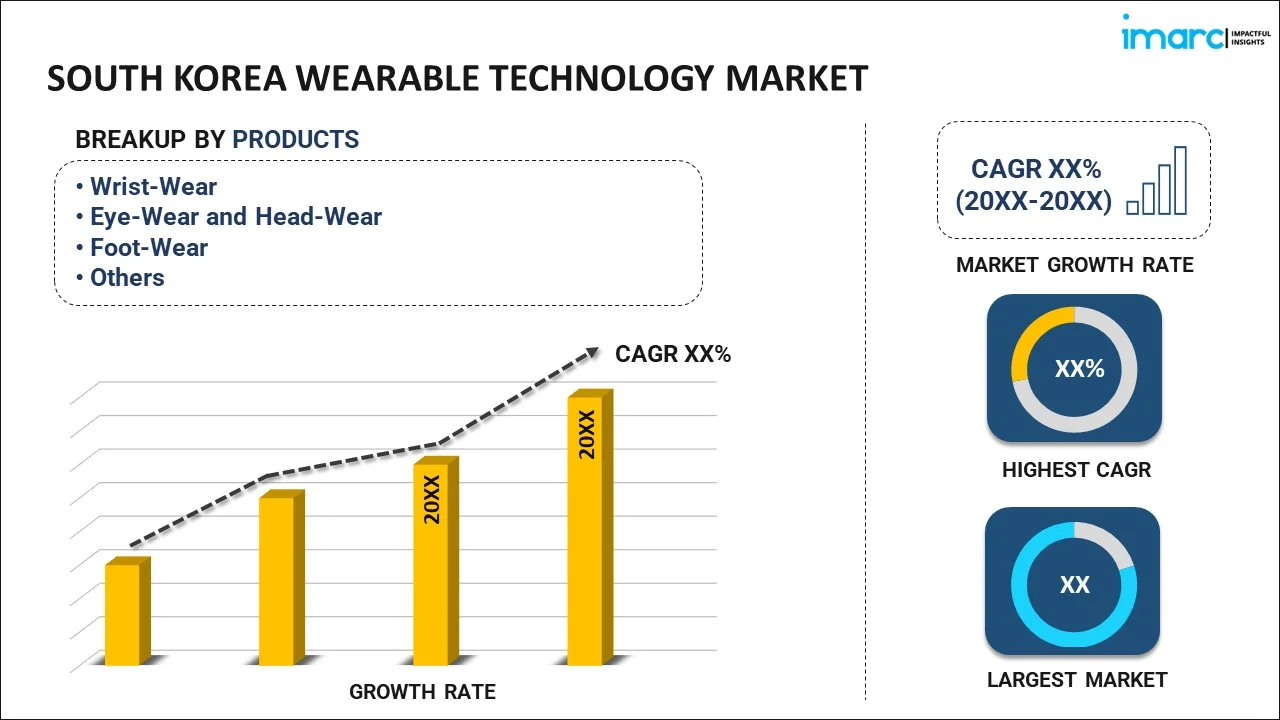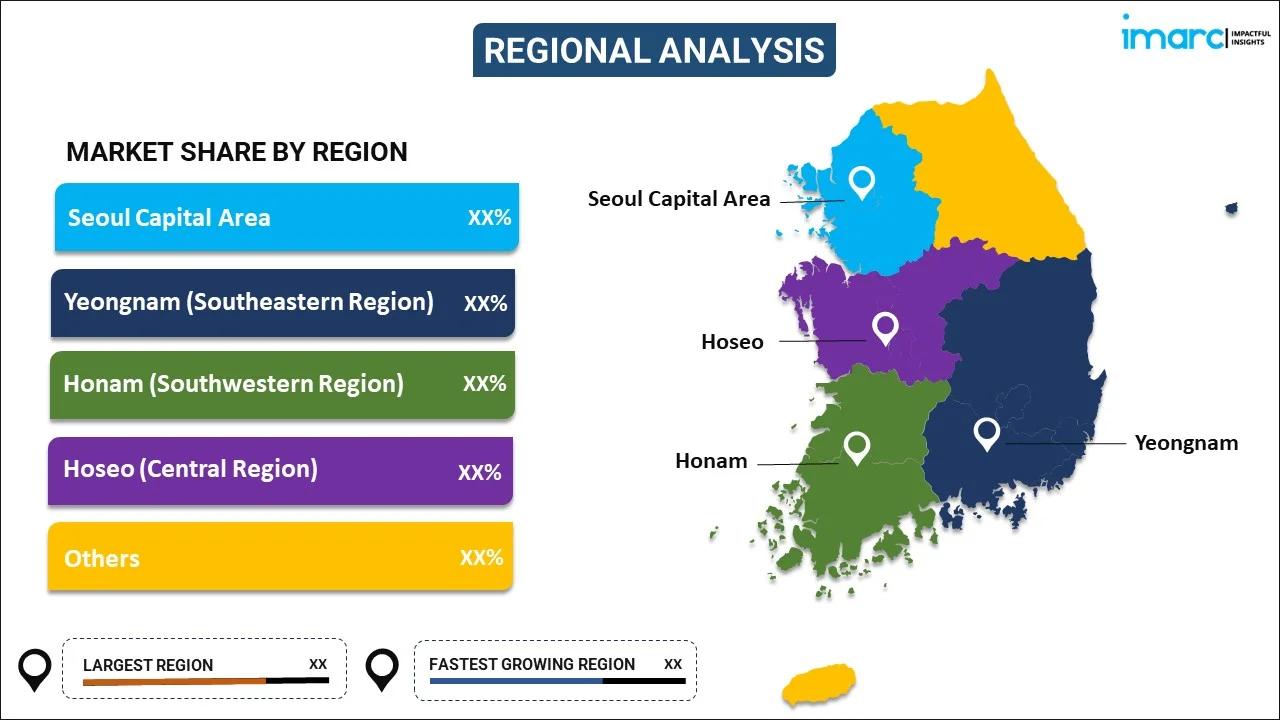
South Korea Wearable Technology Market Report by Product (Wrist-Wear, Eye-Wear and Head-Wear, Foot-Wear, Neck-Wear, Body-Wear, and Others), Application (Consumer Electronics, Healthcare, Enterprise and Industrial Application, and Others), and Region 2025-2033
Market Overview:
South Korea wearable technology market size is projected to exhibit a growth rate (CAGR) of 17.2% during 2025-2033. Ongoing technological innovation, escalating health consciousness, favorable government initiatives, smartphone integration, fashion and aesthetic appeal, remote work trends, and the incorporation of artificial intelligence (AI) and machine learning (ML) capabilities represent some of the key factors driving the market.
|
Report Attribute
|
Key Statistics
|
|---|---|
|
Base Year
|
2024 |
|
Forecast Years
|
2025-2033 |
|
Historical Years
|
2019-2024
|
| Market Growth Rate (2025-2033) | 17.2% |
Wearable technology are electronic devices designed to be worn on the body, typically in the form of accessories or clothing, with the primary purpose of providing users with access to computing and connectivity functionalities. These devices are equipped with processors, sensors, and wireless communication capabilities, enabling them to collect and transmit data while seamlessly integrating into the user's daily life. Some of the standard wearable technologies include smartwatches, fitness trackers, augmented reality (AR) glasses, and health monitoring devices. Wearable technology serves a diverse range of applications, from tracking fitness metrics and monitoring health vitals to delivering notifications, navigating, and even enhancing AR experiences. The evolution of miniaturized components, advancements in material science, and the proliferation of mobile connectivity have driven the popularity and innovation in wearable technology. As these devices continue to merge fashion with functionality, they play a transformative role in areas such as healthcare, sports, entertainment, and daily productivity, offering users a more personalized and connected experience in their day-to-day activities.
South Korea Wearable Technology Market Trends:
The pervasive influence of technological innovation, with continuous advancements in sensor technology, miniaturization, and battery life driving the development of more sophisticated and user-friendly wearables, is primarily driving the market growth. Besides this, the growing consumer demand for multifunctional devices that seamlessly integrate into their lifestyles is strengthening the market growth. Moreover, an increasingly health-conscious population in pursuit of a healthier lifestyle, coupled with the escalating awareness of preventive healthcare, is fueling the demand for wearable health and fitness trackers that help monitor physical activity, sleep patterns, and vital signs. In confluence with this, the government's emphasis on fostering a digital economy and smart technology adoption is acting as another significant growth-inducing factor. The market is further influenced by extensive investments in research and development (R&D), fostering innovations in wearable technologies. Concurrently, the widespread use of smartphones and their integration with wearables for enhanced functionalities, along with the expanding appeal of smartwatches as fashion accessories and status symbols, contributes to their increasing popularity among consumers, boosting the market growth. In addition to this, the rise of remote work and the need for connectivity in the post-pandemic era drive demand for smart devices that facilitate seamless communication and productivity, creating a positive outlook for market expansion. Furthermore, the introduction of cutting-edge features and the implementation of aggressive marketing strategies and celebrity endorsements to attract consumers are providing an impetus to the market growth. Apart from this, the integration of AI and ML capabilities in wearables to enhance user experiences is presenting lucrative opportunities for market expansion.
South Korea Wearable Technology Market Segmentation:
IMARC Group provides an analysis of the key trends in each segment of the market, along with forecasts at the country level for 2025-2033. Our report has categorized the market based on product and application.
Product Insights:

- Wrist-Wear
- Eye-Wear and Head-Wear
- Foot-Wear
- Neck-Wear
- Body-Wear
- Others
The report has provided a detailed breakup and analysis of the market based on the product. This includes wrist-wear, eye-wear and head-wear, foot-wear, neck-wear, body-wear, and others.
Application Insights:
- Consumer Electronics
- Healthcare
- Enterprise and Industrial Application
- Others
A detailed breakup and analysis of the market based on the application have also been provided in the report. This includes consumer electronics, healthcare, enterprise and industrial application, and others.
Regional Insights:

- Seoul Capital Area
- Yeongnam (Southeastern Region)
- Honam (Southwestern Region)
- Hoseo (Central Region)
- Others
The report has also provided a comprehensive analysis of all the major regional markets, which include Seoul Capital Area, Yeongnam (Southeastern Region), Honam (Southwestern Region), Hoseo (Central Region) and Others.
Competitive Landscape:
The market research report has also provided a comprehensive analysis of the competitive landscape in the market. Competitive analysis such as market structure, key player positioning, top winning strategies, competitive dashboard, and company evaluation quadrant has been covered in the report. Also, detailed profiles of all major companies have been provided.
South Korea Wearable Technology Market Report Coverage:
| Report Features | Details |
|---|---|
| Base Year of the Analysis | 2024 |
| Historical Period | 2019-2024 |
| Forecast Period | 2025-2033 |
| Units | Million USD |
| Scope of the Report | Exploration of Historical Trends and Market Outlook, Industry Catalysts and Challenges, Segment-Wise Historical and Future Market Assessment:
|
| Products Covered | Wrist-Wear, Eye-Wear and Head-Wear, Foot-Wear, Neck-Wear, Body-Wear, Others |
| Applications Covered | Consumer Electronics, Healthcare, Enterprise and Industrial Application, Others |
| Regions Covered | Seoul Capital Area, Yeongnam (Southeastern Region), Honam (Southwestern Region), Hoseo (Central Region), Others |
| Customization Scope | 10% Free Customization |
| Post-Sale Analyst Support | 10-12 Weeks |
| Delivery Format | PDF and Excel through Email (We can also provide the editable version of the report in PPT/Word format on special request) |
Key Questions Answered in This Report:
- How has the South Korea wearable technology market performed so far and how will it perform in the coming years?
- What has been the impact of COVID-19 on the South Korea wearable technology market?
- What is the breakup of the South Korea wearable technology market on the basis of product?
- What is the breakup of the South Korea wearable technology market on the basis of application?
- What are the various stages in the value chain of the South Korea wearable technology market?
- What are the key driving factors and challenges in the South Korea wearable technology?
- What is the structure of the South Korea wearable technology market and who are the key players?
- What is the degree of competition in the South Korea wearable technology market?
Key Benefits for Stakeholders:
- IMARC’s industry report offers a comprehensive quantitative analysis of various market segments, historical and current market trends, market forecasts, and dynamics of the South Korea wearable technology market from 2019-2033.
- The research report provides the latest information on the market drivers, challenges, and opportunities in the South Korea wearable technology market.
- Porter's five forces analysis assist stakeholders in assessing the impact of new entrants, competitive rivalry, supplier power, buyer power, and the threat of substitution. It helps stakeholders to analyze the level of competition within the South Korea wearable technology industry and its attractiveness.
- Competitive landscape allows stakeholders to understand their competitive environment and provides an insight into the current positions of key players in the market.
Need more help?
- Speak to our experienced analysts for insights on the current market scenarios.
- Include additional segments and countries to customize the report as per your requirement.
- Gain an unparalleled competitive advantage in your domain by understanding how to utilize the report and positively impacting your operations and revenue.
- For further assistance, please connect with our analysts.
 Inquire Before Buying
Inquire Before Buying
 Speak to an Analyst
Speak to an Analyst
 Request Brochure
Request Brochure
 Request Customization
Request Customization




.webp)




.webp)












